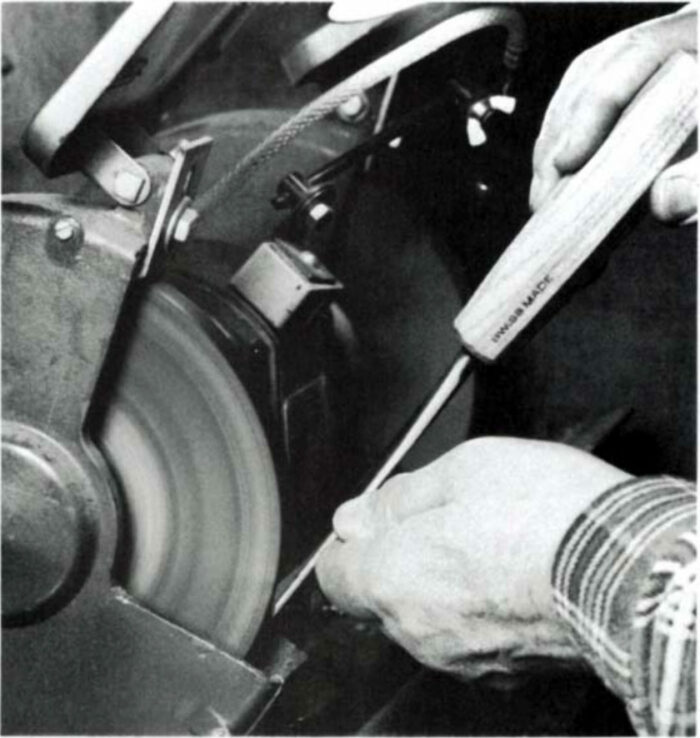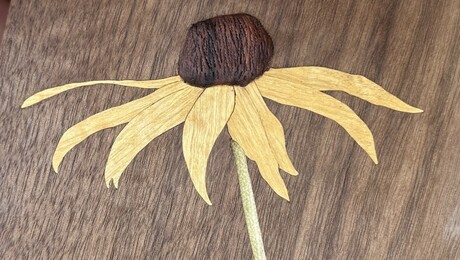Sharpening to a polished edge
This article is from issue #39, published in March/April 1983.
I’ve heard so many craftsmen complain about the length of time (and the expenditures for equipment) involved in bringing tools to a razor-sharp edge that I feel I must pass on the sharpening method I’ve evolved in the fifty-odd years I’ve been making shavings and sawdust.
My first mentor taught me to do it all by hand, using three grades of oilstones, with the final edge honed on a waterstone like those used to prepare a straight razor for the final stropping. After all these years I can still hear him saying, “If you can’t shave with it, don’t try to carve with it.” While I can’t disagree with his goal, his process was, at best, tedious. I began to search for methods that would let me spend more time using my tools than I was spending sharpening them.
An interest in gunsmithing led me to take courses in machine-shop practice, pattern making and tool making. This, coupled with several years of machine-shop experience during World War II, taught me that there was a great deal more to sharpening a tool than scrubbing it back and forth on a flat stone, oil or otherwise.
I learned, to my surprise, that a coarse-grit grinding wheel properly dressed with a diamond dresser could remove metal faster than a fine-grit wheel, and leave a very good finish, with less chance of burning. And I found that using mist to cool the edge while grinding practically eliminates burning.
Then I discovered that buffing the ground edge on a hard felt wheel charged with gray compound would leave a razor edge. I also learned that to produce a good, even bevel on a tool, a positive rest (for gouges and small chisels) and a holding jig (for plane blades and wide chisels or skews) are absolute necessities. I have seen the results of freehand grinding by craftsmen who really thought that they were getting good results, until they tried sharpening with my rig.
The grinder I use is an old model Craftsman (Sears) X-HP with an 8-in., 36-grit wheel. The wheel is 1 in. wide and leaves a hollow grind that is neither too shallow nor too deep. You can adapt my system to whatever grinder you have. I removed the tool rest that came with the machine and fitted a 20-in. long arm that extends down in front of the grinding wheel. It is made from two pieces of I -in. angle iron (preferably stainless steel) welded or bolted together by means of separators at each end so that there is a 6-in. slot running its whole length. I bolted the arm to the clamp that came with the grinder, which allows the arm to pivot up and down. It can be clamped at whatever angle is necessary.
As a socket for tool handles, I made a wooden V-block about 4 in. long and attached it to the arm by means of some strap iron and a carriage bolt extending through the slot. It can be secured at any point by tightening a wing nut. These two adjustments make it easy to get just the right bevel, whether the tool is a long-and-strong turning gouge or a small carving gouge.

For sharpening plane blades, skew chisels, skew turning tools, and chisels that are wider than the wheel, I use a tool holder that rides on a 1-in.-wide, 7-in.-long piece of strap iron that can be adjusted parallel to the axis of the wheel. I wax the tool rest; it makes the jig slide much more easily. The strap iron can remain in place, as it will not get in the way when you are using the V-block. I use the strap-iron rest in dressing the wheel with the diamond dresser, a small diamond chip mounted on the end of a handle. When the diamond contacts the spinning wheel, it removes glaze and trims off any high spots. You won’t get a good edge unless your wheel is free of glaze, perfectly round, and vibration-free. The ideal way to diamond-dress a wheel, of course, is to have the dresser mounted in a fixture that has a micrometer adjustment into the face of the wheel and a screw-feed across it.

However, a little practice with the dresser, moving it slowly across the face of the wheel with very light, even pressure, can make you very adept at it. Diamond dressers can be obtained from any machine-tool dealer who handles grinding machines. A good one costs about $60, but it will last a long time. I’ve had mine for 25 years.
I use a compressed-air-driven misting device to cool the cutting edge while I grind. I won’t go so far as to say that you can’t burn an edge using mist, but it sure makes it a whale of a lot more difficult. The mist also keeps the wheel cleaner and thus minimizes dressing. I usually use plain water in the misting device, but coolant concentrates are available from mill suppliers, and I would especially recommend the use of one with a good rust inhibitor if the water in your area tends to be acidic. The misting device I use is manufactured by Kool Mist Corp.; it costs about $22 and works fine at 40-lb. air pressure. If you do not have a compressor and do not wish to invest in one, you might try using plant sprayers or some other source of sprayed water instead. But mist, generated by high pressure, is a much more efficient coolant than water. People who use water come close to drowning.
Once I have ground the edge to the point where some people would accept it as sharp, I return to the felt wheel, buffing the tool as shown in the photo above. This leaves a secondary bevel that has the strength to make many cuts before needing a touch-up. A felt wheel as large as, or larger than, the grindstone can leave a fairly flat bevel, whereas the usual kind of polishing wheel, sewn cloth, would undesirably round the edge. You can get a 5/8-in.-wide, 8-in. hard felt wheel for about $50 from Paul H. Gesswein and Co.
When I buff, I hold the heel of the bevel slightly away from the wheel, which results in a secondary bevel about 1/16 in. wide across the cutting edge. Use very little pressure; too much and the cutting edge will be burned, and you will have to start over. In fact, most of the time I shut off the motor and get a good edge as the motor runs down. For touching up the tool while working, I make three or four passes over a smooth leather strop, leading with the heel of the bevel. The strop is simply a piece of leather belting stretched over a heavy hardwood block and soaked with a light mineral oil. I charge the strop by vigorously rubbing gray compound into it. One application lasts a long time. This strop restores the cutting edge amazingly well and cuts down on the number of trips to the buffing wheel. No doubt, there will be those who will read this article and not be moved to try the method. For those who do decide to give it a whirl, however, I can guarantee that you will have no regrets—and very sharp tools.
Editor Recommended Diamond Grinding Wheel
Wen Diamond Grinding Wheel
Diamond grinding wheel is perfect for flattening grinding wheels before honing chisels and plane blades
Price: $9.43 at the time of writing

Editor Recommended Mist Coolant System
Mist Coolant System
A mister for keeping tools cool while you hone them on your grinder. This mister has a base that can be screwed to a support near your grinding wheel or drill press. It conveniently hooks up to a small shop compressor, and by charging it with coolant, you can keep tools rust free.
Price: $9.99 at the time of writing

Editor Recommended Honing Compound
Honing Compound
This honing compound is great for loading into a buffing wheel and polishing an assortment of metals.
Price: $9.95 at the time of writing

Sign up for eletters today and get the latest techniques and how-to from Fine Woodworking, plus special offers.









